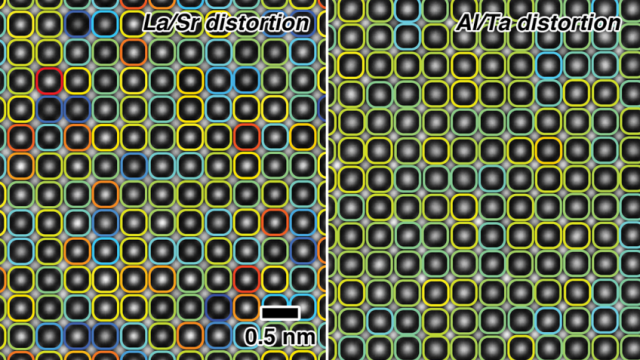 The image on the left shows distortion of lanthanum and strontium directly resolved at the the atomic scale. Blue and red colors indicate contraction and expansion of the local structure respectively. The image on the right shows that the aluminum and tantalum sites exhibit dramatically different distortion behavior due to bonding. (Image credit: James LeBeau)
The image on the left shows distortion of lanthanum and strontium directly resolved at the the atomic scale. Blue and red colors indicate contraction and expansion of the local structure respectively. The image on the right shows that the aluminum and tantalum sites exhibit dramatically different distortion behavior due to bonding. (Image credit: James LeBeau)
This new research opens the door for various studies on the impact of these distortions on material characteristics. Researchers have known for years that the arrangement of atoms in a complex material, such as an alloy, greatly influences the characteristics of the material.
“We knew where the atoms were on average, but we also knew that there were variations in a material – there can be significant displacements, where atoms don’t fit into that average pattern,” said Dr. Doug Irving, an associate professor of materials science and engineering at NC State and co-author of a paper describing the new work.
“However, detecting these distortions required indirect methods that could be difficult to interpret, so we couldn’t fully explore how a material’s atomic structure affects its properties,” said Dr. James LeBeau, an assistant professor of materials science and engineering at NC State and the corresponding author of the paper.
.jpg)
“Now we’ve come up with a way to see the distortions directly, at the atomic scale. We can create a precise map of atomic organization, including the distortions, within a material. Not only which atoms fit into the structure, but how far apart they are, and how distortions in the structure are related to the chemistry of the material,” LeBeau said.
The work is carried out based on the technique developed by LeBeau known as revolving scanning transmission electron microscopy (revolving STEM).
The researchers observed the complex material - lanthanum strontium aluminium tantalum oxide (LSAT) in order to evaluate the technique and obtain insights on the bonds between chemical links and structural deformities. They chose LSAT due to its considerable variability in the chemical bonding within the material.
“It’s a mess. We didn’t know how the complexity of those bonds influenced structural distortions, and we wanted to see if revolving STEM would give us any insights,” LeBeau said.
The researchers observed that the weaker bonds holding strontium and lanthanum within the atomic structure of LSAT are responsible for minute variations in the chemical environment. “We never would have been able to directly see the extent of that variation before,” LeBeau said.
Now that we can see these subtle distortions, and know what causes them, the next step is to begin work to understand how these structural differences affect specific properties. Ultimately, we hope to use this knowledge to tailor a material’s properties by manipulating these atomic distortions.
Dr. James LeBeau, an assistant professor of materials science and engineering at NC State
The paper was published in the journal Applied Physics Letters. Dr. Xiahan Sang, a postdoctoral researcher at NC State is the lead author of the paper. Everett Grimley and Changning Niu, Ph.D. students at NC State are the co-authors of the paper.